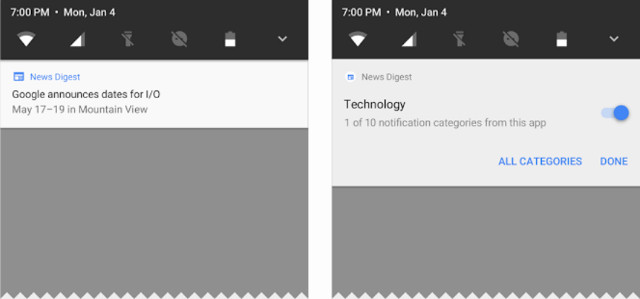Nearly exactly one year after Android N developer preview release, Google has now announced the release of Android O developer preview in order to get feedback from the developer community before the official release of Android 8.0? Oreo? in Q3 2017.
So what’s new so far in Android O? Here are some of the changes:
- Background activity limits – Automatic limits on what apps can do in the background for implicit broadcasts, background services, and location updates.
- Notification channels – New app-defined categories for notification content for better control from the use, as user may only block or change the behavior from one channel, instead of applying the same behavior to all notifications from a given app. For example, a News app may have notifications for Technology, Sports, Politics, International, etc…

- Autofill APIs – Platform support for autofill, where users can select an autofill app, similar to the way they select a keyboard app, with the app securely storing addresses, user names, and even passwords.
- PIP for handsets and new windowing features – Picture in Picture (PIP) display is now working on phones and tablets, so users can continue watching a video while they’re answering a chat or hailing a car. Other window features include overlay window and multi-display support.
 Font resources in XML – Apps can now use fonts in XML layouts as well as define font families in XML — declaring the font style and weight along with the font files.
Font resources in XML – Apps can now use fonts in XML layouts as well as define font families in XML — declaring the font style and weight along with the font files.- Adaptive icons – Icons that can be displayed in different shapes, e.g. round or rounded square based on a mask selected by the device. Animated interactions with the icons are also supported.
- Wide-gamut color for apps – Android developers of imaging apps can now take advantage of new devices that have a wide-gamut color capable display.
- Connectivity
- Support for high-quality Bluetooth audio codecs such as LDAC codec.
- Wi-Fi Aware support, aka Neighbor Awareness Networking (NAN), allowing to discover and communicate over WiFi without an Internet access point
- Extension of ConnectionService APIs to enable third party calling apps integrate with System UI and operate seamlessly with other audio apps.
- Keyboard navigation – Better use of “arrow” and “tab” navigation key for systems connected to keyboard such as Chrome OS with Google Play.
- AAudio API for Pro Audio – Native API designed for high-performance, low-latency audio.
- WebView enhancements – Multiprocess mode enabled by default, and new API for errors and crashes handling.
- Java 8 Language APIs and runtime optimizations – New Java Language APIs, such as java.time API. Android Runtime is up to 2x faster on some application benchmarks.
Google has provided system images for Nexus 5X, Nexus 6P, Nexus Player, Pixel, Pixel C, and Pixel XL devices. You’ll find more details about the preview on Android Developer website.

Jean-Luc started CNX Software in 2010 as a part-time endeavor, before quitting his job as a software engineering manager, and starting to write daily news, and reviews full time later in 2011.
Support CNX Software! Donate via cryptocurrencies, become a Patron on Patreon, or purchase goods on Amazon or Aliexpress






